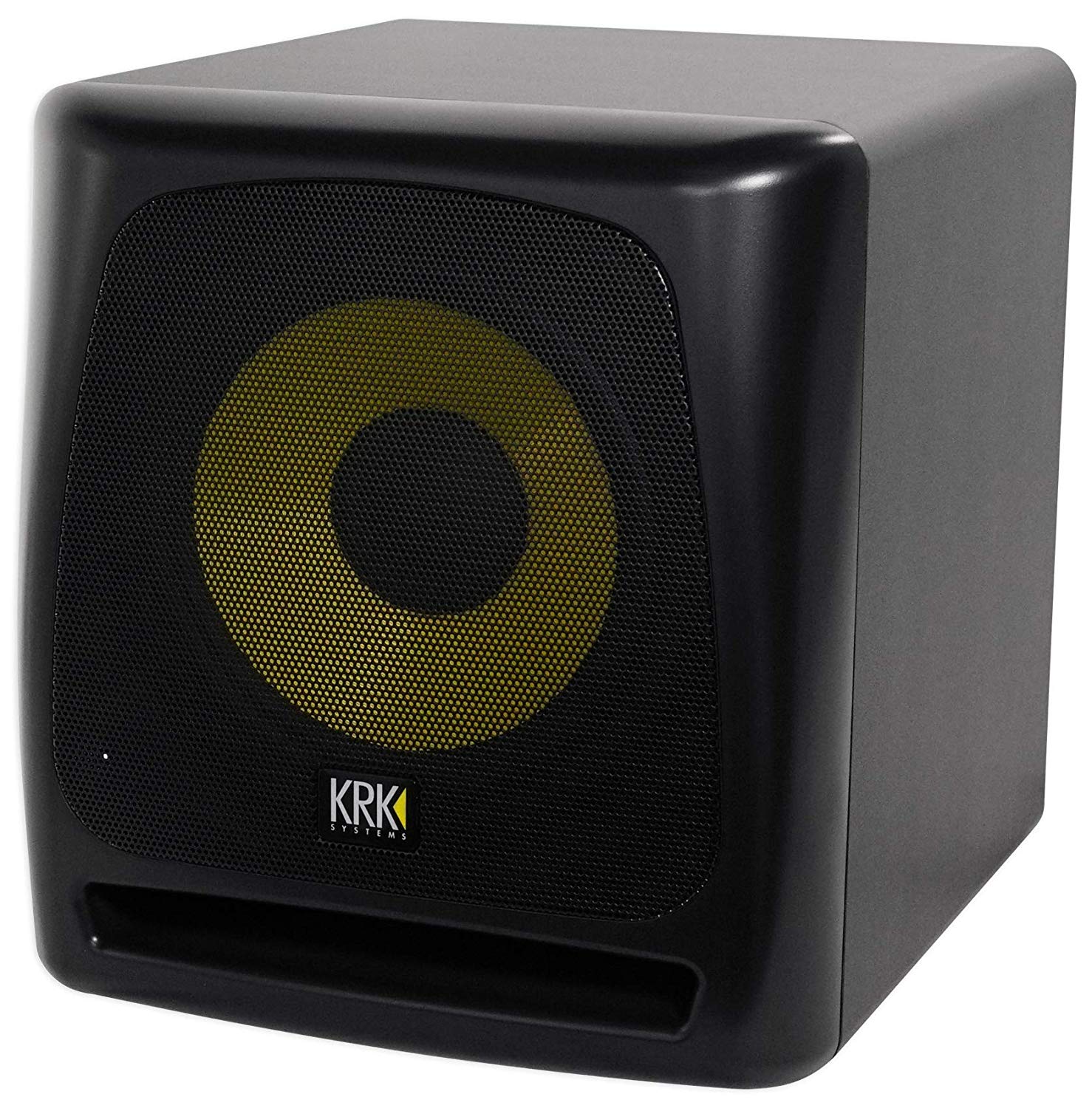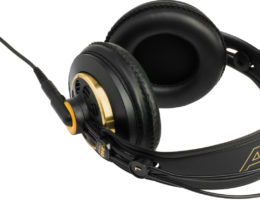Today, we’re looking at a KRK 10s review.
That’s right; I want to talk a little about the low-end—and how you can make up for the low-frequency that your studio monitors might be lacking.

Balancing low frequencies and bass sounds is tedious—even more so if you can’t hear it. It’s an essential part of the mixing process. If you don’t balance mix your low end properly, the mix and sound quality of your track will suffer greatly.
No matter how great your studio monitors are—whether you’re working with a pair of Rokit 5s or Rokit 8s, it can be hard to really hear the bass of the track that you’re working on—especially if your focus is sound design. A solid sub monitor like the KRK 10s can do wonders for making those lower frequencies audible.
When it comes to making music, it’s all about finding equipment that is capable of capturing the right balance. You want to be able to enjoy the full experience of rich sounds and emotions that are in a track.
This is where your subwoofer comes in.

The subwoofer is the perfect complement to the rest of your speaker system. If you want to experience the full depth of your songs, you definitely want to pick up a solid studio subwoofer.
With no further ado, this KRK 10s review will help you determine if this sub is the right choice for you. I think the KRK 10s is a great choice and incredibly versatile—I own one myself, and have for a couple of years now.
It isn’t too pricey compared to others, but it delivers quality. It’s a popular model, and it’s also on its second generation. Sometimes you can really benefit from getting a second version. The first release of anything usually has some flaws. After customers give feedback, companies make sure to improve their new products. The result is a better buy for you.
Check Price On Amazon
Why Do I Need a Subwoofer?

Usually, the bigger the “kicker” the better the low-end range (the “BASS”). Subwoofers are an enormous help if you’re delving deep into sound design, mixing and mastering, or just production itself. Depending on your setup you may not have access to high-quality, full-range monitors like the Rokit 10-3s.
What usually winds up happening is you sacrifice the low end. Almost all speakers can reproduce the high end well, up to frequencies that you can’t even hear. But reproducing the low end is a lot harder. These speakers rarely have a range below 35-40Hz. Large nearfield monitors can come close, but even in these cases, there’s a limit.
Quality subwoofers can faithfully reproduce sounds down to around 28-30Hz. You want to avoid distorting sound in the process. This frees your speakers up to focus on the high end. It lets your bass come through another device, leading to a much more visceral and immersive experience.
The great thing about the KRK 10s is that it can be used in these larger settings, or in a home studio. Not everyone has a subwoofer in their home studio, but the 10s is compact and affordable. When you’re mixing, you can really get a sense of what your finished product might sound like in a club or live scenario.
KRK Systems

KRK has been making quality monitors and subwoofers for years. The first 10s came out years ago. More recently, KRK Systems released an update. It works well with other KRK equipment, like VXT or Rokit studio monitors.
It’s true, KRK subwoofers are easily added to their other equipment. But they work with many monitors or speaker systems. If you have a different brand of monitors, you can still match the two. Their recent line can be a huge help in improving your low-frequency extension.
Our KRK 10s Review

KRK’s 10s studio subwoofer is a glass-aramid woofer that is capable of generating a defined bass sound. It builds upon the successes of its predecessor. The 10s is a 10-inch speaker, and the series also includes an “8s” and a “12s”.
For my money, I want something a little richer than what the 8s can provide. But there’s a significant difference in price between the 10s and the 12s. The 10s can be a little bit of a better choice if you’re watching your budget.
Basic Specs
- 10″ glass aramid composite woofer
- Bass can go down to 28Hz
- Maximum SPL of 117 dB
- HPF bypass footswitch control allows you to control the sub and crossover filter
- Frequency cross-over options
- Front-firing bass port
- Class D amplification
- Ground lift controls
Check Price On Amazon
Build and Style

The build quality is excellent. The MDF enclosures give a level of durability that beats anything else in its price range. Other pieces of equipment can more easily be lost to damage. Subwoofers often get bumped, kicked, dropped, dinged, or even suffer the accidental water damage. The 10s weathers these wear-and-tear challenges much better.
The aramid composite woofers are especially strong. Aramid is a material used by space and military organizations for armor. A detachable metal grille adds a solid layer of protection. So these subwoofers are not only strong, but they have plenty of shielding.
Like the older 10s version, the new KRK 10s keeps its curved edges. The shape of the baffle makes it more durable. It also reduces phase incoherence, and muddy sound.
The sleek and curved design helps you immediately identify it as a KRK. The yellow woofer is signature KRK too. The whole series has a style that is both modern and a little retro. KRK makes most of its monitors and subwoofers like this. The Rockit, Expose, and VXT are all quickly identifiable in the same way. If you already have any of these, the 10s will look right at home alongside them.
Weight
The 10s weighs about 30 lbs. This is not bad when considering how heavy some of these pieces can get. And it can make a huge difference if you’re planning on moving around the 10s at all.
Frequency Response
Now for the part that really counts. How does it sound? What does the KRK subwoofer deliver in terms of hitting those low frequencies?
I like the 10s because its frequency response is as low as 31Hz easily. KRK says it can go as low as 28Hz.
Hooking it Up

Start by hooking your audio interface outputs into the inputs on the subwoofer.
Next, connect your monitors to the output of the subwoofer. Fortunately, you can easily bypass the subwoofer when necessary with the use of the footswitch input.
Check Price On Amazon
Foot Switch

Example: Fender 1/4″ (TRS) Footswitch
You can also connect a footswitch if you need it. This makes bypassing the sub easy and efficient, without reconfiguring all of your connections each time.
While the footswitch pedal doesn’t come with the subwoofer, there is an input for it, and any 1/4″ footswitch will do the job.
Having the option to bypass the subwoofer is nice if you have roommates. It’s also nice just to be able to switch back and forth to hear your mix with and without.
Without a footswitch, it would be quite inconvenient.
Controls and Connections
Input Sensitivity Switch
An input sensitivity switch allows you to adapt to different input sources and avoid distortion. The options are “Normal” and “High.” Basically, having it on will make the volume knob much more sensitive.
Polarity Switch
A simple 0 to 180 polarity switch enables you to avoid running into phase issues that can occasionally crop up.
Stand-by Switch
When stand-by is on, the subwoofer will turn off when no audio is coming through. If Stand-by is off, the subwoofer power will be determined by the power switch alone, meaning it could easily be left on and drawing power by mistake.
Ground Lift Switch
The ground lift switch gives you a boost in combating electrical noise in the event of a looped signal. This will eliminate the humming that can come as a result.
Check Price On Amazon
Crossover Knob
Essentially, this knob (with options 60Hz, 70Hz, 80Hz, and 90Hz) is allowing you to set the frequency range that your monitors handle vs the subwoofer.
For example, if you set the crossover at 90Hz, your subwoofer will handle frequencies 90Hz and below, while your monitors handle everything above that.
Keep in mind, there is a crossover slope rate of 18db/octave (if this sounds like jibberish, don’t worry—not super important). This just means that the crossover is gradual—it’s not an instant cutoff at those frequencies. So your monitors and subwoofers will be working well together.
Volume Knob
This one is pretty self-explanatory. I will say, be mindful of your “input sensitivity switch.” If it’s on, it will make the volume knob much more sensitive.
Also keep in mind, you want to set up your sub to work well in unison with your monitors to MONITOR the bass (not to crank the bass). The goal is to be able to hear the low-end frequencies you were otherwise missing—not boost them artificially. Doing so won’t result in an advantage.
Inputs
Pick one of the following and plug your audio interface (or whatever your source of sound is) here. Your sound will go through the subwoofer first, and then out to your monitors/speakers.
Unbalanced: Also known as RCA, this is the red and white input.
Balanced: These input options include 1/4″ jack inputs and XLR inputs. Both are simply a different kind of cable.
What’s the difference between Unbalanced and Balanced? In layman’s terms, balanced is better. Unbalanced is more likely to have grounding issues, resulting in a buzzing sound, or loss of audio quality.
Outputs
Your studio monitors should be connected to the output of the subwoofer. The same as above goes for balanced and unbalanced.
Sub & HPF Bypass Footswitch Input
This input is where you’ll plug in your footswitch, if you choose to get one. From here you can easily bypass your subwoofer.
Other Perks
The on-board amplifier is able to run at high levels and still avoid distortion. The 10s also has something called an LFE, or “Low Frequency Effects” connection. That helps you connect it to a 5.1 surround system.
Whether you pair the 10s subwoofer with studio monitors from KRK or from another designer, you’re going to get a great sound. The low end gets boosted in a major way, beyond what most similarly priced subwoofers can offer. Connecting the subwoofer to both your audio source and your monitors generates a comprehensive, full-range audio experience.
Check Price On Amazon
The Best Studio Subwoofer For You

Currently, the KRK 10s subwoofer is listed on Amazon at a competitive price, and it’s worth every penny. If you tend to move your studio around, you can take it with you without having to have multiple people load it into your ride. It can take on a bit of wear and tear, too, without falling apart.
If you’re just designing in a home studio, you’ll be able to get a ton of mileage out of it. I look at it more from the point of view of someone mixing and mastering and creating. It never hurts to really be able to hear those lower frequencies while you’re working. The bass is satisfying and rich. For an affordable, quality sound, this subwoofer is definitely worth a look.





